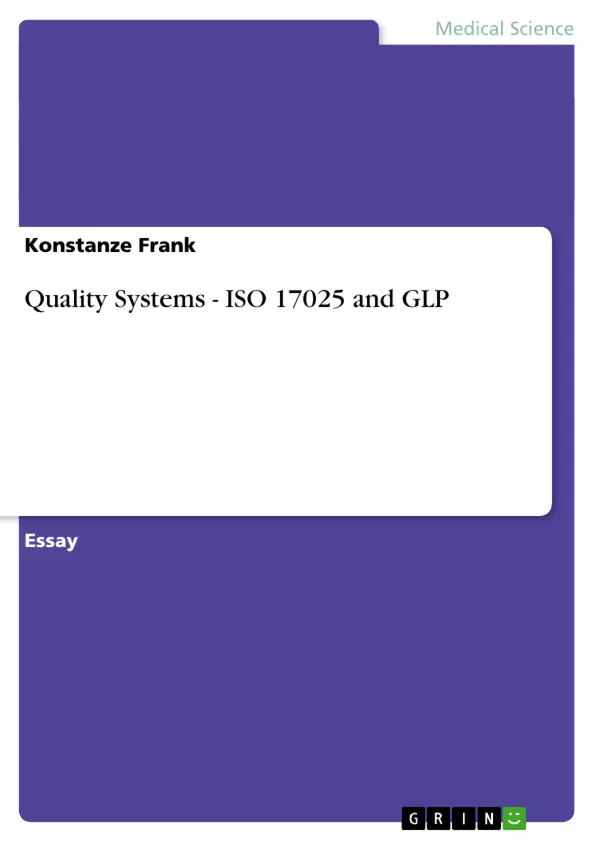An accredited laboratory according to ISO/IEC 17025 and a research facility working according to the Organisation for Economic Co-operation and Development Good Laboratory Practice (OECD GLP) series of principles, both facilities perform chemical, analytical and microbiological tests. The main difference is the types of projects that the laboratories deal with.
OECD GLP facilities conduct studies for the purpose of testing and assessing chemicals to determine their potential hazards. The GLP principles are a managing tool covering the organisational process and the conditions under which laboratory studies are planned, performed, monitored, recorded and reported. Whereas accredited laboratories are testing and calibration laboratories. They operate a quality system, are technically and scientifically competent, and are able to generate technically valid and traceable results.
There are many definitions of Quality. One possibility might be to define quality “in terms of customer satisfaction”. As there is no absolute measure hence it should be “management’s task to translate future needs of customers into quality products and services]. Therefore a ‘quality system’ can assist organisations in enhancing customers’ satisfaction. According to Andrew Waddell there are two dimensions of a quality system, a vertical and a horizontal dimension. The requirements of the vertical, i.e. technical, level are covered by ISO 17025 whereas the horizontal, i.e. managing and organisational, concept is detailed in the OECD GLP principles.
However, a comparison of both shows overlapping and/or common requirements in these international standards with unique occurrence in the two of them.
Inhaltsverzeichnis (Table of Contents)
- Coursework Assignment/Section 3 Quality Systems
- Selection of Title
- Introduction
- Overview of common elements of ISO/IEC 17025 requirements and the OECD principles of GLP
- Comparison of common elements of both standards
- Responsibilities, organisation and management
- Quality assurance/ quality control
- Documentation, recording and archiving
- Facility, equipment, apparatus and test, reference and calibration items
- Conclusion
- References
Zielsetzung und Themenschwerpunkte (Objectives and Key Themes)
This coursework assignment aims to analyze the common elements of ISO 17025 and the OECD Principles of Good Laboratory Practice (GLP), highlighting their unique features and the reasons behind them. The assignment delves into the specific expectations and requirements of various stakeholders involved in quality systems. It also explores how these needs can be translated into specific objectives, and the processes and mechanisms for measuring their effectiveness.
- Comparison of ISO 17025 and OECD GLP standards
- Stakeholder expectations and requirements within quality systems
- Translating stakeholder needs into specific objectives
- Processes and mechanisms for measuring the effectiveness of quality systems
- Application of quality systems in accredited laboratories and GLP testing facilities
Zusammenfassung der Kapitel (Chapter Summaries)
- Coursework Assignment/Section 3 Quality Systems: This chapter introduces the assignment's scope and objectives, focusing on the comparison of ISO 17025 and OECD GLP standards. It also outlines the key questions and tasks to be addressed.
- Selection of Title: The chapter discusses the chosen title for the coursework, justifying the selection of the first title for a thorough analysis of the quality systems of accredited laboratories and GLP testing facilities.
- Introduction: This chapter provides an overview of accredited laboratories operating under ISO/IEC 17025 and research facilities adhering to OECD GLP principles. It highlights the main differences between their operations and emphasizes the importance of quality systems in ensuring customer satisfaction and meeting evolving needs.
- Overview of common elements of ISO/IEC 17025 requirements and the OECD principles of GLP: This chapter provides a general overview of the common elements present in both ISO/IEC 17025 and OECD GLP standards. It explores the reasons behind the inclusion of these elements and their relevance in the context of each standard.
- Comparison of common elements of both standards: This chapter delves into a detailed comparison of the common elements present in ISO/IEC 17025 and OECD GLP standards. It explores the unique features of each standard and the reasons behind these differences. Specific areas covered include responsibilities, organization, management, quality assurance/quality control, documentation, and facility requirements.
Schlüsselwörter (Keywords)
This coursework assignment focuses on the key concepts of quality management, accreditation, ISO 17025, OECD GLP, stakeholder expectations, quality systems, and the common elements and unique features of these standards. The assignment also explores the relationship between quality systems and customer satisfaction, and the mechanisms for measuring their effectiveness.
- Quote paper
- Konstanze Frank (Author), 2004, Quality Systems - ISO 17025 and GLP, Munich, GRIN Verlag, https://www.grin.com/document/41153



